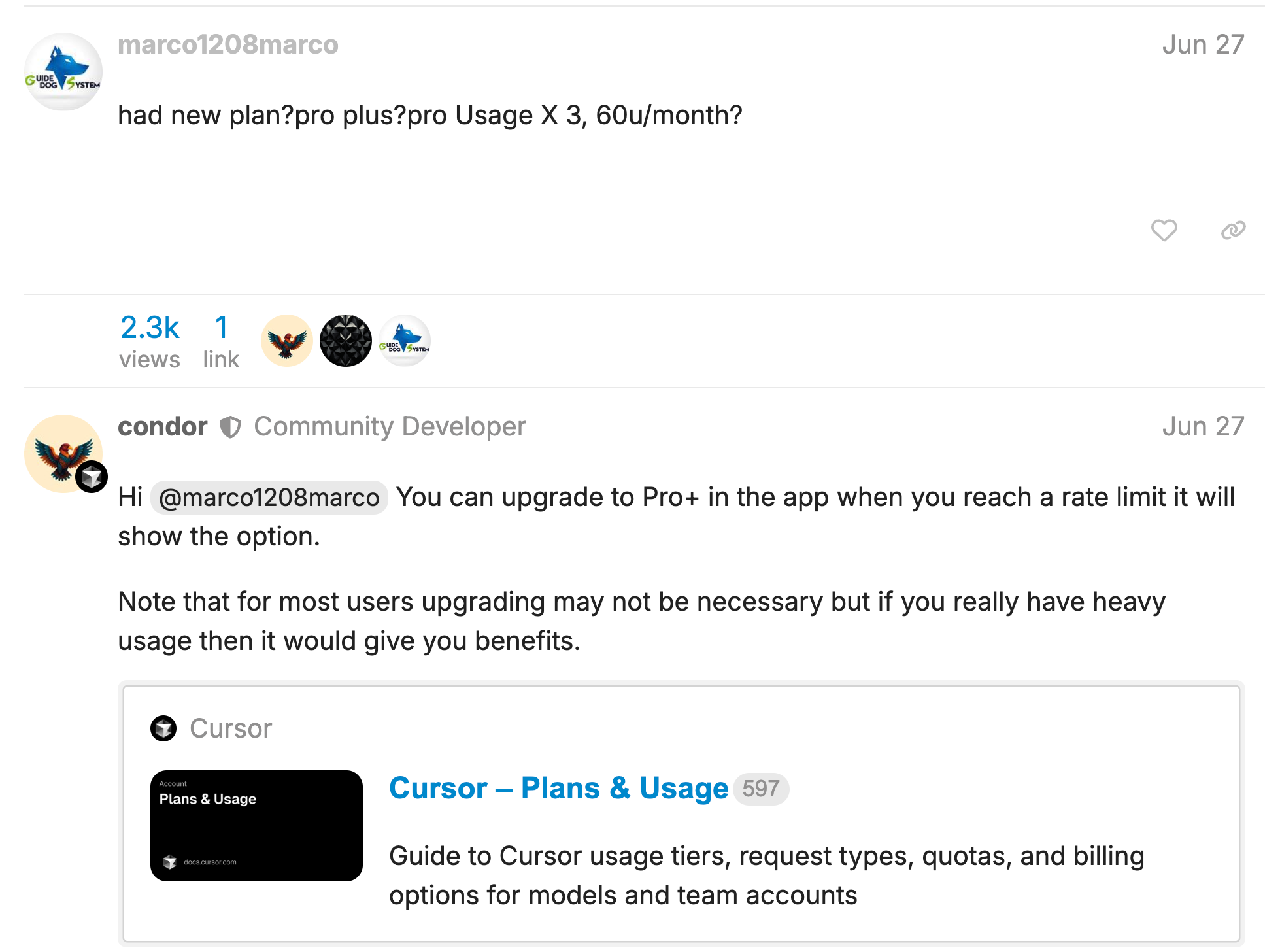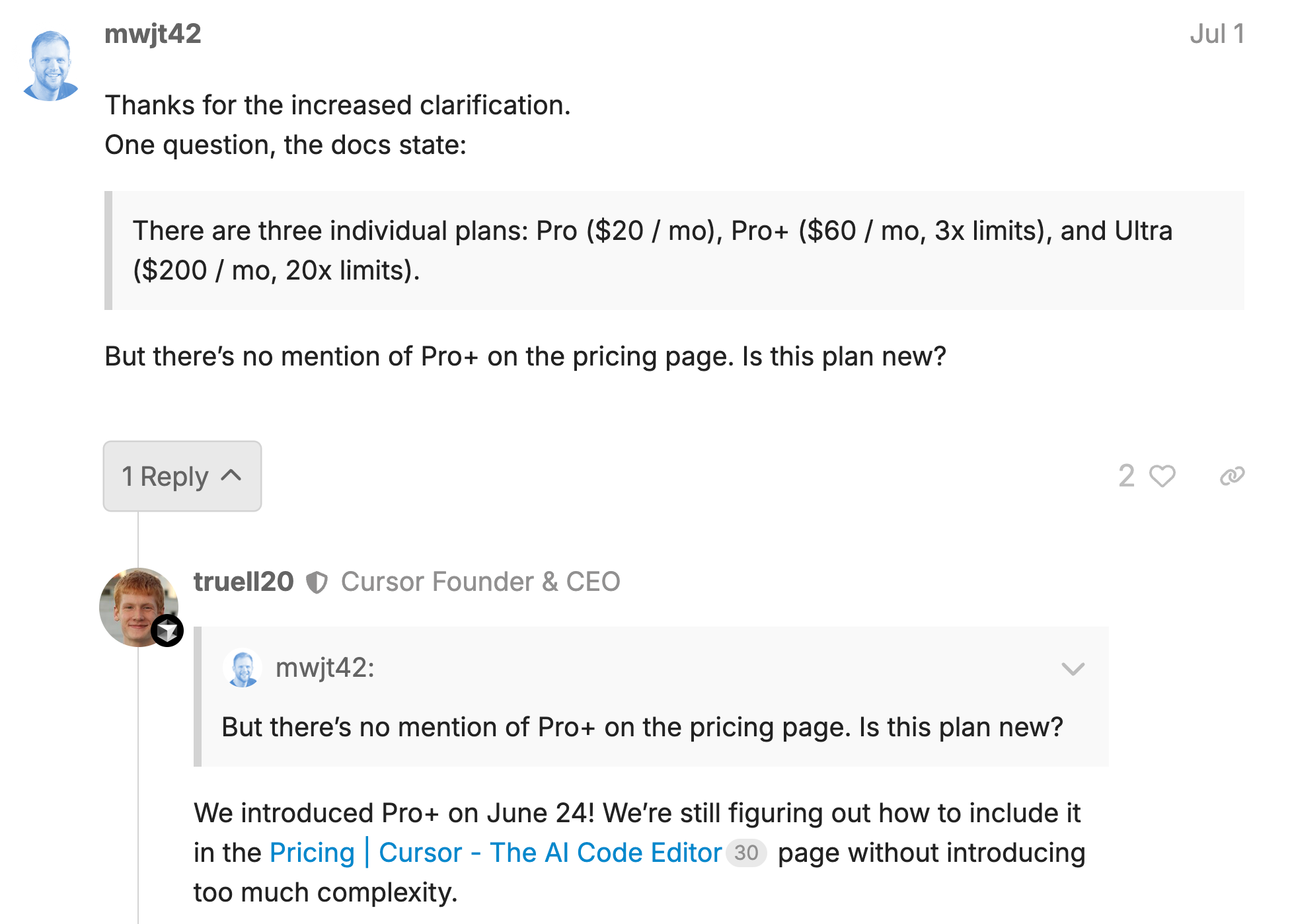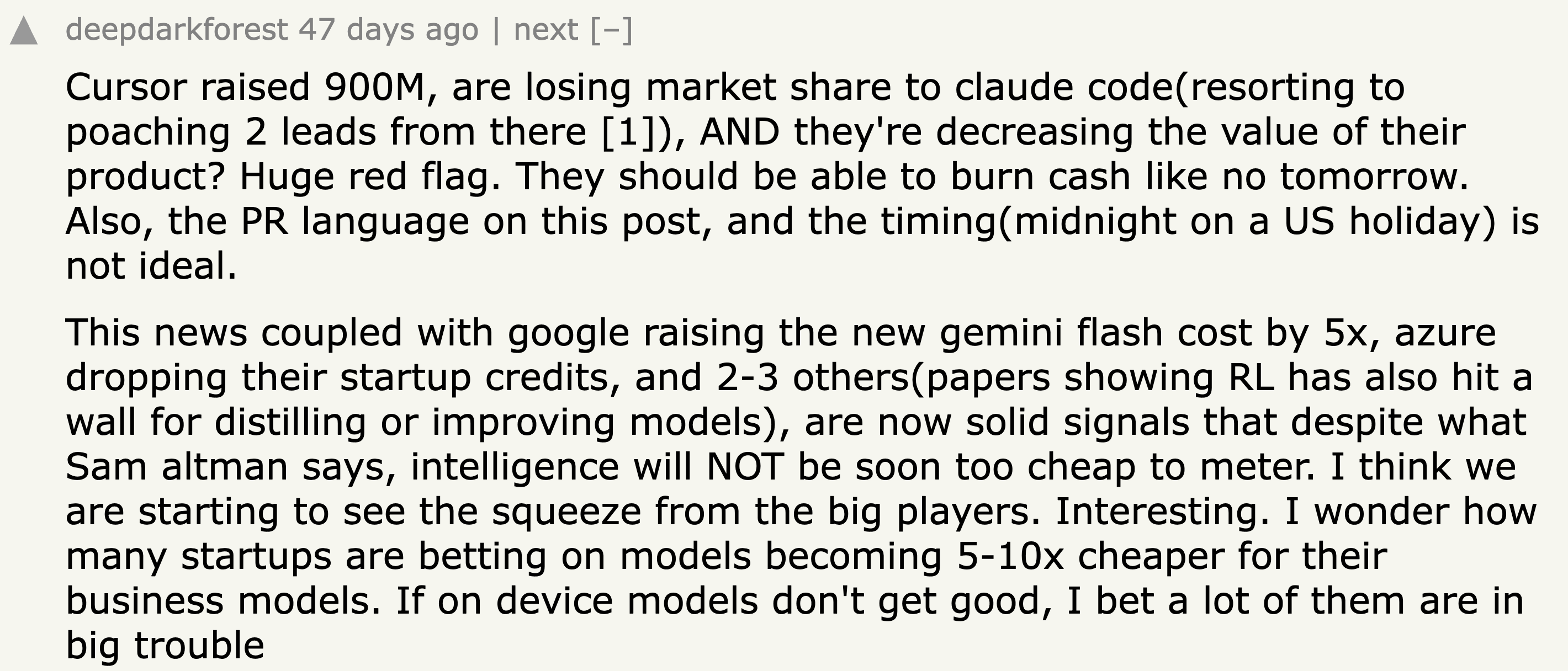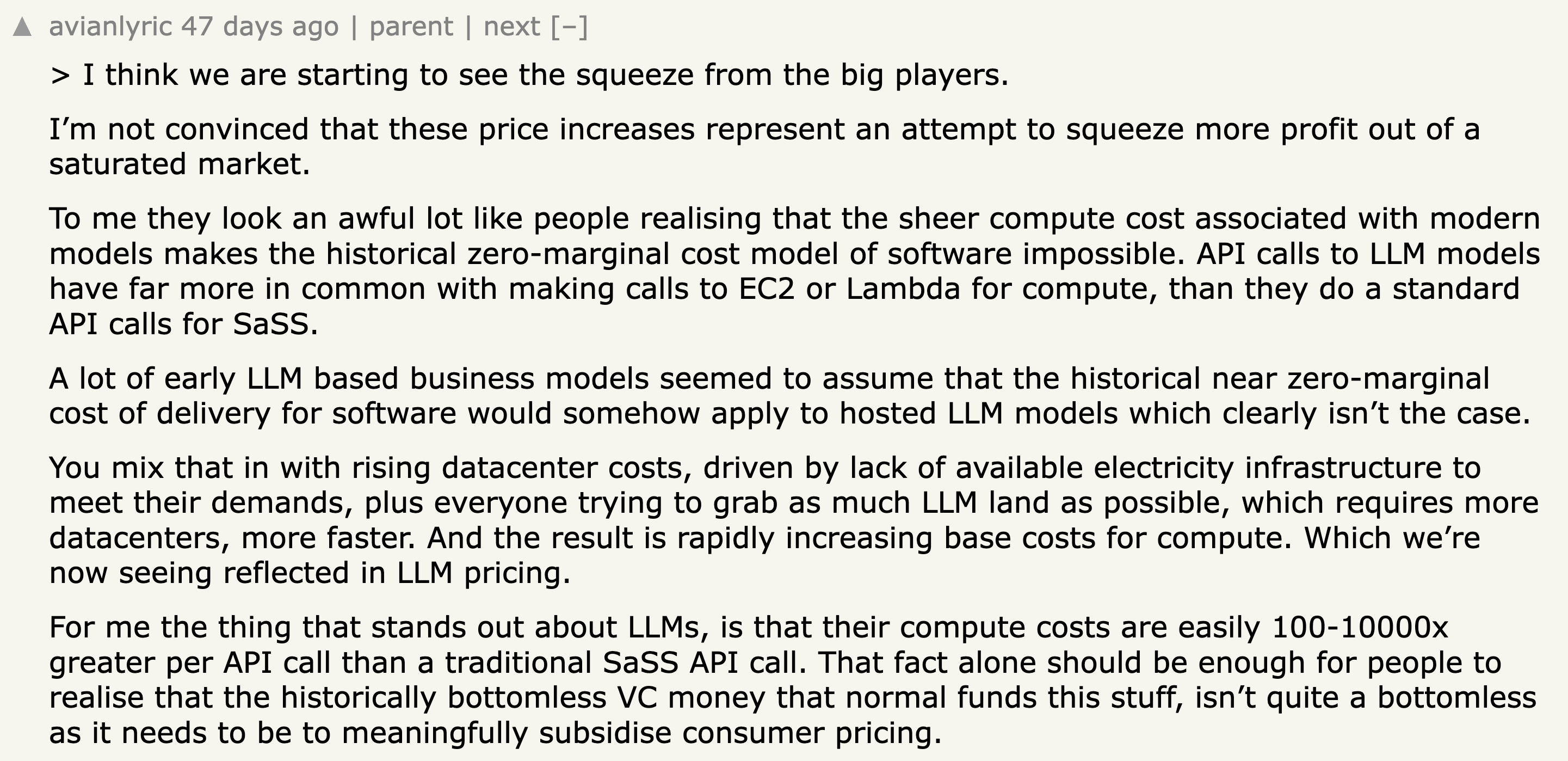
If we’ve learned anything these past couple of months, it’s that the companies behind all these shiny new AI coding tools really are wrestling with the messy reality of usage limits, power users, and skyrocketing inference costs.
For example, Anthropic transitioned Claude subscribers to stricter weekly usage caps, while Replit introduced “effort-based pricing” for its AI coding agent, linking costs to task complexity.
Anysphere, the company behind the hugely popular AI coding editor Cursor, also created a stink back in June when it switched the structure of its existing Pro plan, as it introduced a new super-premium Ultra plan. The change replaced Pro’s familiar request-based setup with a credit-based system pegged to underlying AI inference costs, leaving many developers uncertain about the value they were getting and, in some cases, facing unexpected charges.
Cue the community uproar, the company’s follow-up “clarification,” and the inevitable apology from Anysphere CEO Micahel Truell over its communication missteps.
“We recognize that we didn’t handle this pricing rollout well, and we’re sorry,” Truell wrote. “Our communication was not clear enough and came as a surprise to many of you. We’re improving how we communicate future pricing changes.”
The core underlying issue was that there were so many different things happening in tandem, some of which weren’t really communicated at all (“clearly” or otherwise). And this left users struggling to piece together what had actually changed until they were already feeling the impact in their back-pocket.
So here, we unpack everything that changed, and what it means for individual developers.
Cursor still offers a free hobbyist tier that includes around 2,000 code completions and 50 slower premium-model requests, in addition to a two-week Cursor Pro trial. This is ideal for light-use developers, or those looking to “suck it and see” before jumping in.
The main change relates specifically to Cursor Pro, which switched from a $20/month plan offering 500 fast requests plus unlimited slower ones, to a $20 credit-based allowance, with all requests now drawing from the same pool.
At the same time, Anysphere also quietly introduced a new Pro Plus plan, a tier which isn’t explicitly listed on its Pricing page, but which is mentioned in some of its documentation. As such, this caused a fair bit of confusion in the community. Put simply: how does one actually go about subscribing to this Pro Plus tier – and how much does it cost? One user asked about the upgrade on the Cursor community forum, with a team member responding that the option will only show up in the app once they reach their rate limit.

Moreover, the company’s documentation notes that the Pro Plus plan includes $70 worth of API agent usage (plus additional bonus usage), without specifying what the monthly fee is.
Based on user reports, however, the Pro Plus tier costs $60/month.
One Cursor forum user also asked why the Pro Plus plan wasn’t showing up on the pricing page, with Truell himself responding that the company is still figuring out how to include the tier “without introducing too much complexity.”

The all-new Ultra plan, meanwhile, costs $200 per month, and includes $400 of API agent usage (plus additional bonus usage), as well as priority access to new features.
So in summary, Pro Plus includes more than triple the usage allowance of the new Pro plan ($70 worth of API agent usage compared to $20), while Ultra offers a massive jump to $400 worth, or 20 times the Pro allocation.

On the Pro plan, Daily Tab users (i.e., those who use Cursor’s autocomplete feature), should always remain within their $20 monthly allowance, according to Cursor, while “limited” Agent users (i.e. casual or occasional users) “often stay within the included $20” credit.
Daily Agent users, meanwhile, typically consume in the $60-$100/month range, while power users (i.e. those running multiple agents or heavy automation) often go over $200 in a given month.
A dollar figure alone doesn’t give a clear sense of how far users’ allowance will stretch, since costs vary by model and request size, though Cursor offers rough translations into request counts for a median user.
On the Pro plan, for example, $20 of usage works out roughly to 225 Sonnet 4 requests, 550 Gemini requests, or 500 GPT-5 requests, while Pro Plus scales that up to about 675, 1,650, and 1,500, respectively.

Perhaps unsurprisingly, some users found that their real-world mileage fell well short of expectations once the new system kicked in.
One vented on Reddit in the immediate aftermath of the change, reporting that their “all-day coding with Claude 4” capacity had effectively vanished. “Today, I only managed to get about an hour of coding with it before hitting the new rate limit,” they said.
On the Cursor forum, a long-time Pro user reported his surprise at seeing $10 in usage charges within the first week, while the included request counter had vanished from the UI. They had to opt out of the new pricing model (a temporary option for existing subscribers) to restore visibility, and were frustrated by the lack of communication and clarity around the changes.
“Why, as an active paying customer, didn’t I get any e-mail from Cursor with clear explanation of upcoming changes,” he wrote.
Moreover, the usage data he reported suggests that he was getting a lot less bang for his buck under the new system, burning through half his monthly allowance in just a few days, whereas under the old plan he would still have had most of his fast requests left, and unlimited slow requests available.
Over on Hacker News, discussions have been equally fervent. One user pondered whether Cursor’s price changes were a “huge red flag,” arguing that with $900 million in funding the company should be able to absorb costs instead of reducing value, suggesting the move reflected a broader squeeze by big AI players. Another countered that it was less about profit-taking and more about the sheer compute expense of running LLMs, which are vastly costlier per request than traditional SaaS, with rising datacenter and power costs making price hikes inevitable.


Anysphere, for its part, said it revamped Cursor Pro’s pricing because its old request-based model didn’t reflect the escalating compute costs of modern AI models from third-party providers like Anthropic, OpenAI, and Google: some requests were burning through far more tokens, and costing Cursor more, than others. By switching to a credit-based system pegged to API usage rates, the company can better align its pricing with actual compute costs while still offering “unlimited” access via Auto mode.
This shift also underscores Cursor’s reliance on external models it doesn’t control. Anthropic has taken a different tack with its Claude Code tool, capping usage for power users via weekly limits rather than charging per token. That contrast highlights two divergent strategies: Cursor is passing through third-party costs in a usage-based model, while Anthropic manages its own compute and prioritizes system-wide stability, even if that means capping its biggest spenders.
This divergence hasn’t been lost on the community either. On Hacker News, one commenter argued that Cursor’s huge fundraising ($900 million at a $9.9 billion valuation) made little sense for a product built on an open source editor and third-party LLMs, with no clear “secret sauce” to set itself apart. Indeed, they suggested Cursor’s rise owed more to LLM hype than to unique innovation.
“You want to know what the hype train of Cursor was for?,” they wrote. “It was marketing for LLMs.”